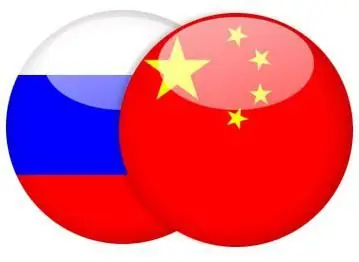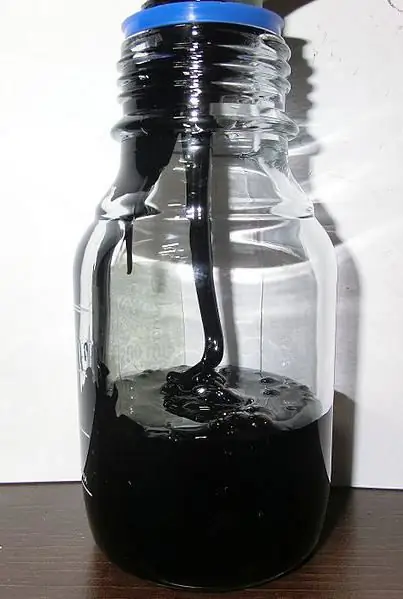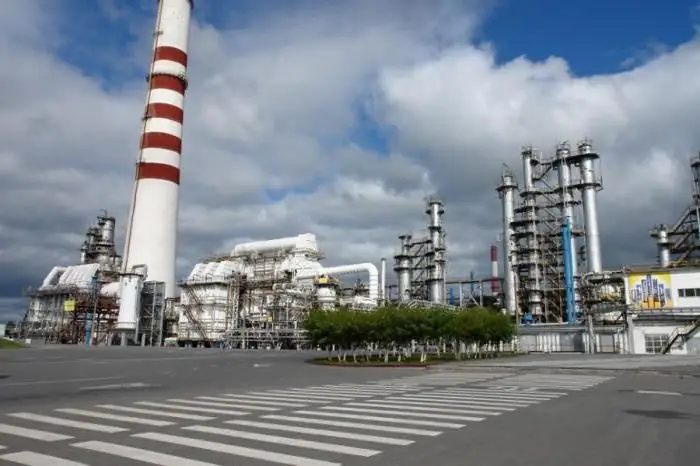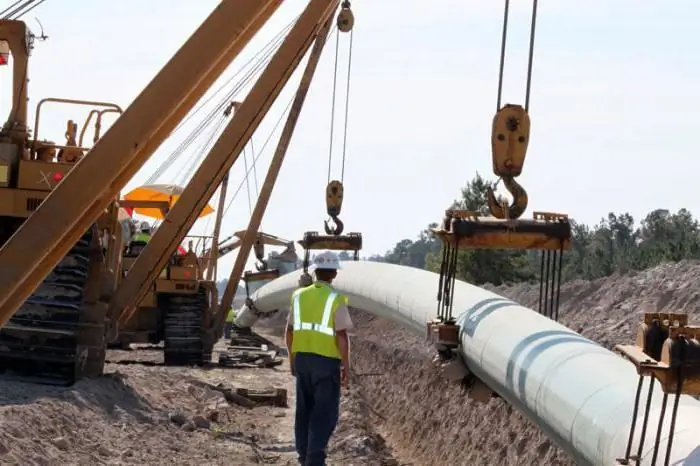2026 Author: Howard Calhoun | [email protected]. Last modified: 2025-01-24 13:10:45
The Eastern Siberia - Pacific Ocean (ESPO) oil pipeline is a grandiose pipeline system. It connects the West Siberian and East Siberian oil fields with the ports of Primorye on the Pacific coast. Ensures the entry of the Russian Federation to the oil product markets of the Asia-Pacific region.
Geography of the route
The ESPO originates in the Irkutsk region, bypasses the Republic of Sakha-Yakutia, the Amur, Jewish Autonomous Regions and the Khabarovsk Territory. The end point of the route is Nakhodka Bay in Primorsky Krai.

The oil pipeline was built by the state company Transneft, and it is also managed by it.
History
The pipeline begins its history from the 70s of the XX century. Then the USSR had plans to build a system of pipelines for the withdrawal of oil from the central regions of the country to the Pacific coast. Preliminary exploration work has been carried out. However, these plans were not destined to come true
But inAt the end of the 20th century, this idea began to be gradually put into practice. The initiator of the construction of the oil pipeline was the management of the Yukos company. However, its end point was China.
The first agreement of intent, the proposed route of transportation and the features of its operation was signed in the summer of 2001 by the Prime Minister of the Russian Federation and the President of the PRC. After that, for some time, representatives of the parties made attempts to implement the project in relation to the interests of a single country, which did not allow the process to move from the "dead point".

In the spring of 2002, the Transneft Corporation developed a project without the participation of the Chinese side. At the same time, the route was supposed to run from Angarsk to Nakhodka. This plan was actively supported by the Japanese government.
A year later, both projects were merged into one - the Eastern Siberia - Pacific Ocean oil pipeline. According to the new plan, the main line of pipelines ran from Angarsk to Nakhodka Bay. At the same time, a branch from it to the Chinese city of Daqing was envisaged.
This summer, after consideration by the environmental commission of the Ministry of Nature of the Russian Federation, the project was rejected, as it was reported to pass through nature conservation areas and reserves. As a result, Transneft was forced to change the starting point from the city of Angarsk to the city of Taishet, and to determine the final point - Kozmina Bay.
Construction
The construction of this largest oil pipeline system began in April 2006. First of allproject, called "ESPO-1" was put into operation in December 2009. It was a pipeline from the city of Taishet to the Skovorodino station (oil pumping station).

The length of ESPO-1 was 2694 kilometers with an oil pumping capacity of 30 million tons per year.
In April 2009, in accordance with earlier agreements, the construction of a branch from the pipeline towards China began. Put into operation at the end of September 2010.
2nd stage of the pipeline "Eastern Siberia - Pacific Ocean" (ESPO-2) was put into operation at the end of 2012. The length of this section, which connected the Skovorodino oil pumping station (Amur Region) with the Kozmino oil port terminal near the city of Nakhodka, is 2046 km.
Characteristics of the piping system
The total length of the Eastern Siberia - Pacific Ocean oil pipeline is 4,740 km. The oil that is supplied by this pipeline system to world markets became known as ESHPO. By the beginning of 2015, the capacity of the first section, ESPO-1, was increased to 58 million tons on an annualized basis. The capacity of the branch to Chinese Daqing, which originates in Skovorodino, is 20 million tons of oil per year.
The commissioning of the oil pipeline made it possible to significantly reduce the cost of laying and supplying power to another large-scale Russian project - the Power of Siberia gas pipeline.
It is assumed that by 2020 the capacity of ESPO-1 will increase to 80 million tons per year.
The oil pipeline system gavethe possibility of connecting two objects of the Far Eastern Russian region to it: in 2015 - the Khabarovsk oil refinery; in 2018 - Komsomolsky.
Currently, design documentation is being developed for the construction of an oil refinery at the end point of the Eastern Siberia-Pacific Ocean pipeline.
Difficulties in laying the track
In the process of laying the ESPO, the builders were forced to solve the most difficult technical issues. This is due to the lack of necessary infrastructure on the ground. The work involved all-terrain vehicles, aviation (helicopters), which exercised control over the general situation.

Construction was seriously hampered by difficult natural conditions such as seismic activity and low temperatures. The terrain along the entire route of the Eastern Siberia - Pacific Ocean oil pipeline also created serious obstacles. Water barriers, impenetrable taiga, swampy areas made it difficult to transport the necessary equipment and maintain the communications under construction.
But despite all the existing problems, the project created the necessary infrastructure: comfortable settlements, roads along the highway, power line systems, treatment facilities, etc. All communications were provided with security and communication systems.
Protests
Before the start of construction, in early 2006, the Eastern Siberia-Pacific Ocean project, which was already ready for implementation, which was developed by the state company Transneft, was rejected. This was due to the fact, according to the stateenvironmental assessment that his route passed in a complex seismological zone near the northern shores of Lake Baikal.

Following actions by Transneft to lobby its plans led to concessions from the State Duma of the Russian Federation, and it lifted restrictions on construction near the Baikal coast.
The processes around the Eastern Siberia oil pipeline also received a great public outcry. Protests were held throughout the proposed route from Baikal to Amur. Especially active environmental activists were against the work of laying the pipeline next to the lake. They argued that the planned protection measures could not prevent serious and catastrophic consequences if an oil spill or other failure of the Eastern Siberia-Pacific Ocean oil pipeline occurred.
The role of the President of the Russian Federation
Gradually, the demands of the public opposed to the construction of the oil pipeline began to acquire political overtones. Some activists began to put forward slogans for the resignation of the government and the President of Russia
President of the Russian Federation Vladimir Putin in the summer of 2006 sided with environmentalists and demanded that the oil pipeline system be laid no closer than 40 km from the northern coast of Lake Baikal.

As a result of such objections from the head of state, the project for the Eastern Siberia-Pacific Ocean (ESPO) pipeline route was revised, and work began much north of Lake Baikal.
Checks
Processes of construction of the pipeline by the corporation "Transneft" were repeatedly subjected to inspections. The first of them was initiated by the State Duma in August 2007. In their request, the initiators pointed to the fact that the terms of work are significantly behind the planned indicators. This led to the beginning of audits by the Accounts Chamber of the Russian Federation (since February 2008) of the development of state funds allocated for the Eastern Siberia - Pacific Ocean oil pipeline.
A year later, it is announced that the verification is completed. According to its results, the fact of distribution without competition of more than 75 billion rubles was established.

In March 2010, S. Stepashin, head of the Accounts Chamber of the Russian Federation, at a speech in the State Duma of the Russian Federation, said that his structure had revealed facts of fraud by the management of Transneft. The state suffered damage in the amount of 3.5 billion rubles. At the initiative of the Accounts Chamber, a criminal case has been initiated, which is being processed by the Investigative Committee of the Russian Federation.
However, in September 2011, Russian Prime Minister Vladimir Putin said that there were no claims against Transneft regarding the construction of the ESPO. No acts subject to criminal prosecution.
Recommended:
Gas pipeline to China. Project and scheme of a gas pipeline to China

Russia and China have signed a long-awaited gas contract. To whom is it beneficial? Will the fact of its signing affect the geopolitical situation?
Oil is a mineral. Oil deposits. Oil production

Oil is one of the world's most important minerals (hydrocarbon fuel). It is a raw material for the production of fuels, lubricants and other materials
JSC "Achinsk Oil Refinery of the Eastern Oil Company"

The Achinsk Oil Refinery of the Eastern Oil Company (AO ANPZ VNK) is the only large oil refinery in the Krasnoyarsk Territory. The plant's capacities allow processing about 7.5 million tons of crude oil annually
Laying a gas pipeline: methods, equipment, requirements. Gas pipeline security zone

Laying of the gas pipeline can be done by underground and ground methods. When choosing equipment for such systems, safety standards should be followed. Actually, the laying of highways is carried out with strict observance of all the required technologies
How is oil produced? Where is oil produced? Oil price

Currently, it is impossible to imagine the modern world without oil. It is the main source of fuel for various transport, raw materials for the production of various consumer goods, medicines and other things. How is oil produced?

